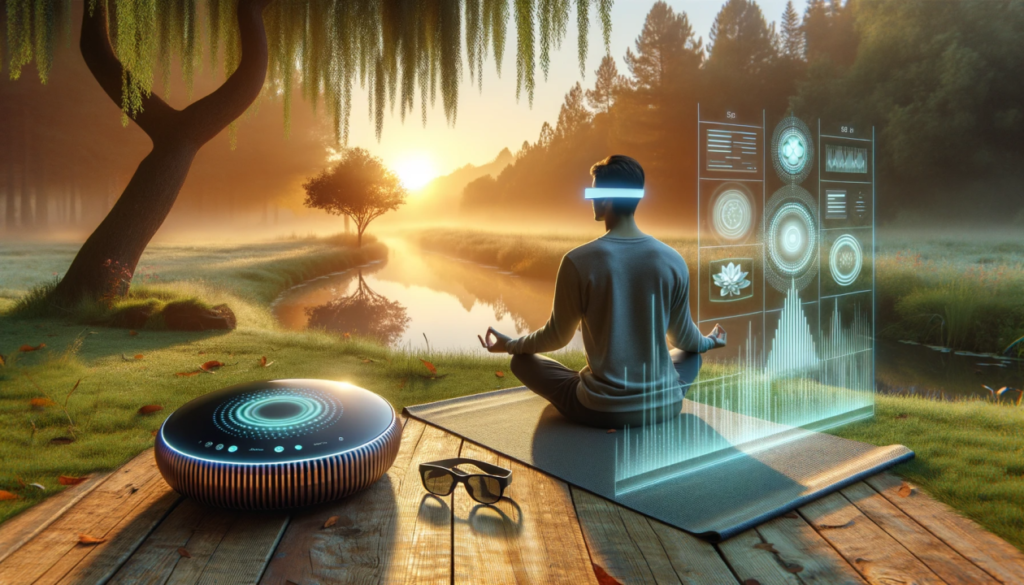
Technology in the Modern Age Meditation
Welcome to the modern age of meditation, where ancient practices meet cutting-edge technology! In today’s fast-paced world, finding moments of peace and tranquility can feel like an elusive pursuit. Thankfully, advancements in technology have made it easier than ever to incorporate mindfulness into our daily lives. Whether you’re a seasoned meditator or just starting on your mindfulness journey, embracing the best tech solutions can enhance your practice and help you achieve a state of calm amidst the chaos. Join us as we explore how meditation and technology converge to create a harmonious balance for mental well-being. Get ready to unlock the power of smart meditation devices, online resources, wearable tech, virtual reality experiences, and more! Let’s dive in and discover how these innovative tools can transform your meditation practice for the better.
The History and Benefits of Meditation
Throughout history, meditation has been practiced in various forms across different cultures and religions. Its roots can be traced back thousands of years, with evidence of its existence found in ancient texts and archaeological discoveries. The practice of meditation is not limited to any specific belief system or ideology; instead, it transcends boundaries and invites individuals to explore the depths of their own consciousness.
One of the key benefits of meditation is its ability to promote mental well-being. By quieting the mind and focusing on the present moment, meditation helps reduce stress, anxiety, and negative thought patterns. It allows us to cultivate a sense of inner peace and clarity amidst the chaos of everyday life.
But the benefits extend beyond just mental health. Regular meditation practice has also been linked to improved physical health. Studies have shown that it can lower blood pressure, boost immune function, improve sleep quality, and even alleviate chronic pain.
Moreover, meditation enhances self-awareness by encouraging introspection and self-reflection. It helps us develop a deeper understanding of our emotions, thoughts, and behaviors. This increased self-awareness enables us to make conscious decisions aligned with our values rather than reacting impulsively based on external factors.
Furthermore, research suggests that regular meditation can enhance cognitive abilities such as attention span, memory retention,and problem-solving skills. By training our minds to focus on one thing at a time through techniques like mindfulness meditation or loving-kindness mediation (Metta), we strengthen our mental faculties for improved concentration and productivity.
In addition to these individual benefits,mass meditations have demonstrated their potential for creating positive social change.
Meditation communities around the world have come together in group meditations aimed at promoting peace,reducing violence,and fostering compassion.
These collective efforts harness the power of intention and serve as reminder so four interconnected as human beings.
As you can see,the history and benefits of meditation are vast and profound.
This ancient practice continues to gain recognition and acceptance in the modern age, as more and more people seek to find balance.
The Impact of Technology on Meditation
In today’s fast-paced, digitally-driven world, it may seem counter intuitive to think that technology can actually enhance our meditation practice. However, when used mindfully and purposefully, technology can offer valuable tools and resources to support and deepen our meditation experience.
One significant way that technology has impacted meditation is through the development of mindful apps and online resources. These apps provide a convenient platform for beginners and experienced practitioners alike to access guided meditations, timers, reminders, and even community support. With just a few taps on your smartphone screen, you can have an entire library of mindfulness practices at your fingertips.
Another exciting advancement in the realm of meditation technology is wearable devices designed specifically for enhancing mental well-being. These smart gadgets track various aspects of your physical health such as heart rate variability or stress levels while providing real-time feedback during your meditation sessions. They serve as gentle reminders to stay present and focused throughout the day.
Virtual reality (VR) has also made its way into the world of meditation. VR offers immersive experiences that transport you to serene environments like lush forests or tranquil beaches—ideal settings for deepening relaxation and concentration during your practice.
When it comes to incorporating tech solutions into your meditation routine, it’s important to strike a balance between leveraging these advancements without becoming overly reliant on them. Remember that at its core, mindfulness is about cultivating awareness in the present moment—a skill we can develop with or without technological aids.
As technology continues to evolve rapidly, we can expect even more innovations aimed at supporting mental health practices like meditation. By embracing these advancements thoughtfully and intentionally integrating them into our lives alongside traditional approaches, we open up new possibilities for growth and transformation in our inner journeys towards peace and clarity.
Mindful Apps and Online Resources for Meditation
In today’s fast-paced, tech-driven world, it’s no surprise that we turn to our devices for help in various aspects of our lives – including meditation. Thankfully, the rise of mindful apps and online resources has made it easier than ever to incorporate a regular meditation practice into our daily routines.
One popular app is Headspace, which offers guided meditation sessions tailored to different goals such as stress reduction or better sleep. With its user-friendly interface and soothing voice guidance, this app can be a great companion for beginners looking to explore the benefits of mindfulness.
Another noteworthy option is Calm, known for its vast library of meditations designed to address specific challenges like anxiety or self-esteem. They also offer calming nature sounds and bedtime stories narrated by celebrities – perfect for winding down after a long day!
If you prefer a more customized approach, Insight Timer might be your go-to choice. This app boasts an extensive collection of guided meditations from teachers around the world along with customizable timer options so you can tailor your practice based on your preferences.
For those seeking community support and motivation while meditating, consider joining online platforms like The Mindfulness App. These platforms provide access to live streaming group meditation sessions led by experienced instructors who create a sense of connection even when practicing alone.
With these mindful apps and online resources at our fingertips, there’s truly no excuse not to embrace the transformative power of meditation in our modern age! So why not take advantage of these digital tools and embark on your own journey towards inner peace and mental well-being?
Wearable Technology for Enhanced Meditation
Wearable technology has become increasingly popular in recent years, and it’s no surprise that it has found its way into the world of meditation. These devices offer a unique way to enhance your meditation practice by providing real-time feedback and guidance.
One example of wearable technology for enhanced meditation is the Muse headband. This sleek device uses sensors to track your brain activity during meditation sessions. It provides you with audio cues to help guide your focus and attention, making it easier to stay present and centered.
Another option is the Spire Stone, a small clip-on device that monitors your breathing patterns throughout the day. It alerts you when your breath becomes shallow or erratic, reminding you to take deep, calming breaths. This can be especially helpful during moments of stress or anxiety when we tend to hold our breath unconsciously.
For those looking for a more immersive experience, there are even virtual reality (VR) headsets designed specifically for meditation. These headsets transport you to serene environments where you can meditate in stunning visuals and soothing sounds.
By incorporating wearable technology into your meditation practice, you can gain valuable insights into how your body and mind respond during different states of relaxation. These devices serve as reminders to prioritize self-care and make mindfulness an integral part of daily life.
As technology continues to advance at a rapid pace, we can expect even more innovative solutions for enhancing our meditation experiences in the future
Virtual Reality Meditation Experiences
Virtual Reality (VR) technology has revolutionized many aspects of our lives, and meditation is no exception. With VR meditation experiences, practitioners can explore new realms of relaxation and mindfulness.
One of the key advantages of VR meditation is the ability to transport yourself to serene environments without leaving your home. Whether it’s a peaceful beach, a tranquil forest, or even outer space, VR allows you to immerse yourself in these calming settings with stunning visuals and realistic sounds.
In addition to creating visually appealing landscapes, VR also provides interactive elements that enhance the meditative experience. Some apps allow users to interact with objects or engage in guided activities within the virtual environment. This added interactivity can help deepen focus and engagement during meditation sessions.
Furthermore, VR meditation experiences often incorporate soothing music and guided audio instructions from experienced teachers. These auditory cues provide guidance for beginners or those looking for specific types of meditations such as breathwork or body scans.
Another benefit of using VR for meditation is its potential for reducing distractions. By wearing a headset that blocks out external stimuli, users can create a more secluded and focused environment conducive to deepening their practice.
While there are still limitations to consider when using VR for meditation—such as potential discomfort from prolonged use—the technology continues to evolve rapidly. As advancements are made in hardware design and software development, we can expect even more immersive and personalized experiences in the future.
Virtual reality offers exciting possibilities for enhancing our meditation practice by providing beautiful environments, interactive elements, guided instructions, and reduced distractions—all within reach through this innovative technology.
Combining Traditional and Technological Approaches to Meditation
In today’s fast-paced, technology-driven world, it may seem counterintuitive to bring together traditional meditation practices with modern technology. After all, isn’t meditation supposed to be a way to disconnect from the distractions of our devices? While there is certainly merit in unplugging and finding stillness within ourselves, it doesn’t mean that we can’t leverage the power of technology to enhance our meditation practice.
One way to incorporate both traditional and technological approaches is by using mindfulness apps. These apps offer guided meditations, breathing exercises, and even reminders throughout the day to help us stay present. They can be a valuable tool for beginners or those who struggle with staying focused on their own.
Another tech solution gaining popularity is wearable devices designed specifically for meditation. These smart gadgets can track heart rate variability (HRV), provide real-time feedback on stress levels, and offer biofeedback training sessions. By wearing these devices during meditation sessions, practitioners can gain insights into their physiological responses and learn how to achieve deeper states of relaxation more effectively.
Virtual reality (VR) has also entered the realm of meditation. VR headsets transport users into immersive environments where they can explore serene landscapes or engage in guided visualizations. This merging of ancient wisdom with cutting-edge technology allows individuals to create an environment conducive to deep relaxation while still utilizing centuries-old techniques.
While incorporating technology into our contemplative practices offers many benefits, it’s important not to rely solely on these tools. Traditional methods such as breath awareness or body scan meditations should always remain at the core of our practice since they cultivate inner awareness without external dependencies.
Combining traditional meditation techniques with modern tech solutions opens up new possibilities for enhancing mindfulness practices in today’s digital age. By embracing these advancements thoughtfully and integrating them into our routines mindfully, we can find greater balance between staying connected in this high-tech world and nurturing our mental well-being. So, whether you choose to explore mindfulness apps, wearables,
Tips for Incorporating Tech Solutions into Your Meditation Practice
Start with a Mindful App: There are numerous mindful apps available today that can guide you through meditation sessions of varying lengths and styles. Look for apps that offer a wide range of features, such as customizable timers, soothing background sounds, and guided meditations led by experienced teachers.
2. Use Wearable Technology: Consider investing in a smartwatch or fitness tracker that includes features specifically designed to enhance your meditation practice. These devices often come equipped with heart rate monitors and stress tracking capabilities, allowing you to monitor your physiological responses during meditation and adjust accordingly.
3. Create an Optimal Environment: Utilize technology to create a serene environment conducive to meditation. Use smart lights to dim the room or change the color temperature according to your preference. Play calming nature sounds or instrumental music using wireless speakers or ambient noise machines.
4. Explore Virtual Reality (VR) Experiences: VR technology can transport you to tranquil virtual environments where you can immerse yourself in breathtaking landscapes or peaceful settings while practicing mindfulness techniques. This immersive experience can deepen your connection with the present moment and enhance relaxation.
5. Set Reminders on Your Devices: With busy schedules, it’s easy to forget about making time for meditation. Take advantage of reminders on your smartphone or other devices by setting regular alerts throughout the day as gentle prompts for taking short breaks dedicated solely to mindfulness practice.
6. Be Mindful of Screen Time: While incorporating tech solutions into your meditation practice can be beneficial, it’s important not to become overly reliant on screens and gadgets during this time of self-reflection and introspection. Set boundaries around screen time usage so that technology remains a tool rather than a distraction from true presence.
By integrating these tech solutions into your meditation routine mindfully, you can harness their potential benefits while maintaining balance between modern technologies and ancient practices.
The Future of Meditation in a High-Tech World
As technology continues to advance at an unprecedented pace, the future of meditation holds exciting possibilities. With the integration of smart devices, wearable technology, and virtual reality experiences, meditation is becoming more accessible and customizable than ever before. The marriage of ancient wisdom with modern innovation allows individuals to embark on their mindfulness journey in a way that suits their unique needs and preferences.
One area where we can expect significant growth is in the development of smart meditation devices. These devices will not only track our mental health but also provide personalized guidance based on real-time data. Imagine having a device that understands your stress levels and offers targeted meditations or relaxation techniques tailored specifically to you! This kind of technology has immense potential for improving overall well-being.
Furthermore, as virtual reality technology becomes more advanced and widely available, we can anticipate immersive meditation experiences that transport us to tranquil environments without leaving our homes. Virtual retreats may become commonplace as people seek solace from the demands of everyday life through these realistic digital escapes.
However, while technological advancements offer incredible opportunities for enhancing our meditation practice, it’s important not to lose sight of the essence of mindfulness itself – being present in the moment and cultivating inner peace. Technology should serve as a tool rather than a substitute for this fundamental aspect.
In this fast-paced world filled with screens and distractions, incorporating tech solutions into our meditation practice can be both empowering and transformative. Whether it’s using mindful apps or wearing smart devices that monitor our mental health throughout the day, these tools allow us to find balance amidst chaos.
As we navigate this high-tech world together, let’s remember that ultimately it’s up to each individual how they choose to embrace or resist these advancements when it comes to practicing mindfulness. Let us always strive for authenticity in our pursuit of inner calm while utilizing technology responsibly as an aid along our path towards self-discovery and well-being.
So go ahead – explore the best tech solutions available, find what resonates with you, and embark on your own unique meditation journey. The future is bright, and there are endless possibilities for how we can integrate technology into our mindfulness practice to enhance our lives in meaningful ways.





